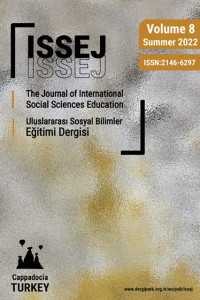Almanca Derslerinde Yaratıcılığı Teşvik Öğretmen Davranışları ve Yaratıcı Aktiviteler
Yaratıcılığı teşvik eden öğretmen davranışları, yaratıcı aktiviteler, Almanca öğretmenleri
Creativity Fostering Teacher Behavior and Creative Activities in German Language Classrooms
___
- Akdağ, M., Güneş, H. (2003). Öğretmen rolünün yaratıcı bir sınıf ortamı oluşturmasındaki önemi.Milli Eğitim Dergisi. 159, 60-73.
- Beghetto, R.A. & Kaufman, J.C. (2007). Toward a Broader Conception of Creativity: A Case for “mini-c” Creativity. Psychology of Aesthetics, Creativity, and the Arts. Vol. 1 (2), 73–79
- Carlile, O. & Jordan, A. (2012). Approaches To Creativity: A Guide For Teachers: A guide for teachers. Open University Press.
- Cropley A. J. (1997). Fostering creativity in the classroom: General principles. M.A. Runco (ed), Creativity research handbook (vol. 1) içinde. Cresskill, N.J: Hampton Press.
- Cropley, A. J. (2001). Creativity in Education and Learning – A Guide for Teachers and Educators. London: Kogan Page.
- Esquivel, G. B. (1995). Teacher behaviors that foster creativity. Educational Psychology Review. 7 (2), 185-202.
- Furnham, A. & Bachtiar, V. (2008).Personality and intelligence as predictors of creativity. Personality and Individual Differences, 45 (7), 613-617.
- Horng, J. S., Hong, J. C., ChanLin, L. J., Chang, S. H. & Chu, H. C. (2005). Creative teachers and creative teaching strategies. International Journal of Consumer Studies.29 (4), 352-358.
- Işık, A. D. (2013). Sınıf öğretmenlerinin yaratıcı bireyler yetiştirmede görev ve sorumlulukları. The Journal of Academic Social Science Studies.6 (6). 585-601 Jauk, E., Benedek,M., Dunst, B. & Neubauer, A. C. (2013). The relationship between intelligence and creativity: New support for the threshold hypothesis by means of empirical breakpoint detection. Intelligence. 41, 212-221.
- Jeffrey, B. & Craft, A. (2004) Teaching creatively and teaching for creativity: distinctions and relationships, Educational Studies, 30:1, 77-87.
- Kampylis, P., Berki, E., & Saariluoma, P. (2009). In-service and prospective teachers‟ conceptions of creativity. Thinking Skills and Creativity, 4(1), 15–29.
- Karpova, E. E., Marcketti, S. B. & Barker, J. (2011). The efficacy of teaching creativity: assessment of student creative thinking before and after exercises. Clothing and Textiles Research Journal. 29 (1), 52-66.
- Lee, I.R. (2013). Pre-service teachers’ personality traits and creative behaviors as predictors of their support of children’s creativity.Yayınlanmamış Doktora Tezi.Florida Universitesi.
- Soh, K. C. (2000). Indexing creativity fostering teacher behavior: A preliminary validation study. Journal of Creative Behavior, 34(2), 118-134. Sternberg, R. J., & O'Hara, L. A. (1999). Creativity and intelligence. In R. J. Sternberg (Ed.), Handbook of creativity (pp. 251–272). Cambridge: Cambridge University Press.
- Yenilmez, K. Yolcu, B. (2007). Öğretmen davranışlarının yaratıcı düşünme becerilerinin gelişimine katkısı. Sosyal Bilimler Dergisi. 18, 95-105.
- Başlangıç: 2011
- Yayıncı: Abdulkadir UZUNÖZ
Almanca Derslerinde Yaratıcılığı Teşvik Öğretmen Davranışları ve Yaratıcı Aktiviteler
Gardner’ın Zihin Tasnifi Işığında Sınıf Öğretmenlerine İlişkin Bir Tahlil Denemesi
Eğitim ve Kalkınma İlişkisinin İncelenmesi
Vedat AKTEPE, Emine CEPHECİ, Sefa IRMAK, Şifa PALAZ
Fen Bilimleri Öğretiminde Tahmin-Gözlem-Açıklama Yönteminin Akademik Başarı ve Kalıcılığa Etkisi
